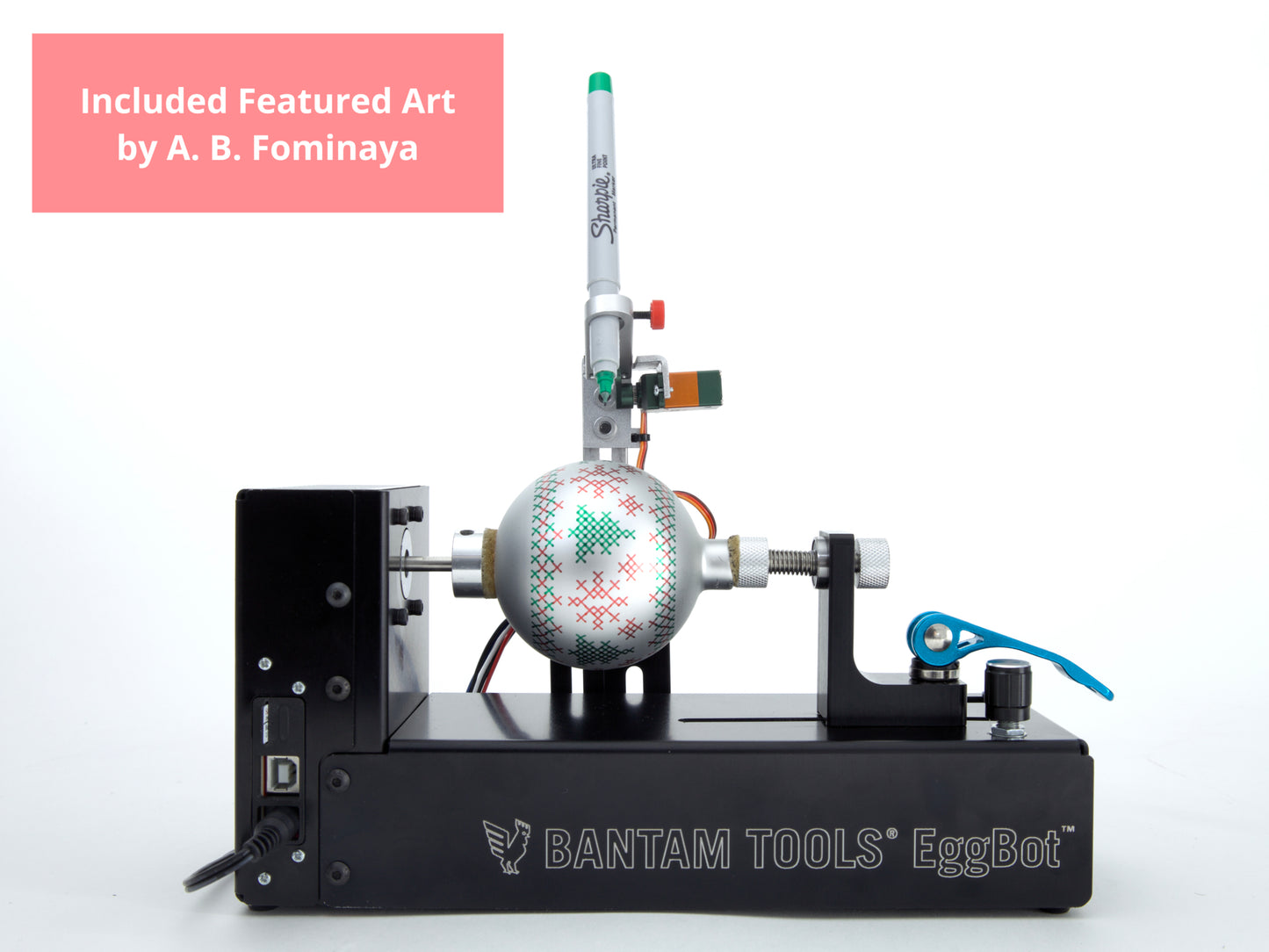Bantam Tools EggBot™ Featured Artists
-

A. B. Fominaya
(Angelica Bonilla Fominaya) is a Colombian artist whose work merges technology, craft, and storytelling. Working across generative systems, textile computation, and machine drawing, she explores how memory, identity, and place can be encoded through digital and material processes. Her practice spans plotter drawings, interactive installations, and algorithmic embroidery, weaving together personal narratives and computational logic to reveal the poetry between human and machine.
-

Andee Collard
Andee Collard is a UK-based artist whose work bridges the digital and the handmade. His practice explores how technology transforms image-making, using generative software to produce oil paintings where algorithmic precision meets painterly imperfection. Collard’s recent series of floral works, created by machines he designed, reflects on beauty, authorship, and the evolving relationship between artist and tool. By foregrounding both process and result, his paintings reveal the friction and harmony between human intention and mechanical execution.
-

Jacob Joaquin
Jacob Joaquin is a digital artist and composer exploring the intersection of sound, code, and generative imagery. Trained in music synthesis at Berklee College of Music and composition at CalArts, he creates algorithmic systems that produce rhythmic, evolving visual and sonic forms. His work bridges programming and performance, using code as both instrument and collaborator to uncover the poetic structures hidden within computation.
-

James Merrill
James Merrill is a fine artist that resides in Vermont, USA. Native to digital mediums, his portfolio includes an eclectic mix of generative, 3D, and machine drawn art.
He presents his artwork through multiple lenses, often utilizing generative code to create static imagery, animations, physical plotter drawings, and interactive art installations. Each artwork is the result of an ongoing exploration of mathematics. His upbringing ignited a passion for breaking barriers by using visuals to self-educate himself on fundamental mathematical concepts.
-

Jennifer Karson
Jenn Karson is an interdisciplinary artist and educator whose work explores the intersection of art, science, and technology. Through generative systems, sound, and digital fabrication, she examines how machines, data, and natural forms can coexist in poetic dialogue. As Director of the UVM FabLab and founder of the Art + AI Research Group, Karson leads research that bridges creative practice with ecological and computational inquiry. Her recent projects use machine learning, plotting, and fabrication to create hybrid artworks that invite viewers to reconsider the boundaries between human and machine, nature and code.
-

Maksim “Maks” Surguy
Maksim “Maks” Surguy is a Ukrainian-born design technologist and digital artist whose work bridges generative art, physical fabrication, and user experience design. His plotter-based artworks and open-source tools explore how code and computation can produce organic, expressive forms. With a background spanning creative coding, hardware prototyping, and interaction design, Surguy’s practice blurs the boundaries between engineering and aesthetics, inviting machines to act as creative partners in visual expression.
-

Martin Bauer
Martin Bauer is a Berlin-based artist known for his abstract art created with largescale industrial laser cutters that are transformed into painting machines. His work explores the interaction between analog and digital methods, producing abstract oil and acrylic paintings. The process emphasizes repetition, structure, and subtle variations, resulting in compositions that feel both systematic and alive. Through his art, Bauer invites audiences to explore the convergence of technology and creativity, where industrial machinery becomes a medium for extraordinary transformation. The artist creates the perfect drawing and the machine adds the errors and imperfections.
-

Nima Nabavi
Nima Nabavi is an Iranian-American artist whose work explores geometry as both structure and meditation. Working with an expanding set of tools from traditional to technological, he creates intricate compositions that balance mathematical precision with intuitive rhythm. His art reflects a deep engagement with pattern, repetition, and the contemplative process of making—bridging the line between traditional geometric abstraction and contemporary computational aesthetics.
-

Paul Rickards
Paul Rickards is a generative artist and engineer with an algorithmic art workflow. Since 2014, he has written custom Python scripts that drive machines to render intricate, one-of-a-kind ink drawings on watercolor paper. His work often explores the CMKY color palette, blending computational logic with the tactile unpredictability of analog media. Rickards bridges historical computing aesthetics and contemporary generative practice, delivering pieces that straddle the boundary between machine precision and human curation.
-

Targz
Targz is a generative artist whose work resides where digital code meets analog gesture. Driven by a lifelong fascination with geometry, legos, and abstract pattern, he develops custom algorithms and pen-plotter systems to translate emergent structure into visual form. Inspired by Op Art and pioneers like Vera Molnar and Bridget Riley, Targz constantly experiments with balance, between randomness and control, visibility and hidden order, to produce compositions that quietly reveal themselves over time. Through his evolving techniques and immersive process-based documentation, he invites viewers to linger in the threshold between the seen and the becoming.
-

Vincent Pidone
Vincent Pidone is a New York–based artist whose work explores the tactile possibilities of surface, texture, and repetition. He transforms traces of the physical world into abstract compositions that feel both deliberate and discovered. His process often involves building depth through wax, pigment, and graphite, allowing material interactions to reveal form and rhythm. Pidone’s practice reflects a curiosity about how mark-making, pressure, and material accumulation can record the dialogue between touch, time, and perception.































